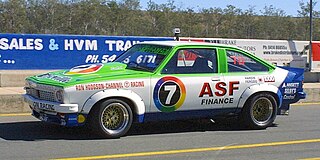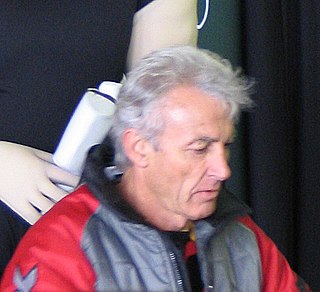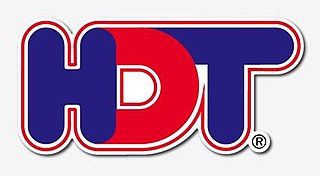
The Holden Dealer Team (HDT) was Holden's semi-official racing team from 1969 until 1986, primarily contesting Australian Touring Car events but also rallying, rallycross and sports sedans during the 1970s. From 1980 the Holden Dealer Team, by then under the ownership of Peter Brock, diversified into producing modified road-going Commodores and other Holden cars for selected dealers via HDT Special Vehicles.

Colin John Bond is a retired Australian racing driver. Bond reached the highest levels in Australian motorsport in 1969 when he was recruited by Harry Firth to the newly formed Holden Dealer Team. He quickly found success, winning the 1969 Hardie-Ferodo 500 mile race at Bathurst, New South Wales in a Holden Monaro.
John GossOAM is an Australian retired motor racing driver who competed in his home country during the 1960s, 1970's and 1980's. He is the only driver to have won Australia's two most prestigious races, the Bathurst 1000, and the Australian Grand Prix (1976).
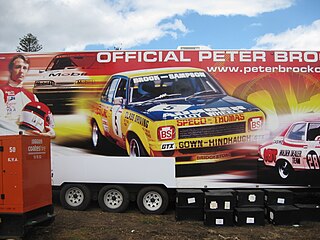
The 1975 Hardie-Ferodo 1000 was the 16th running of the Bathurst 1000 touring car race. It was an endurance race for touring cars complying with CAMS Group C regulations. The event was held at the Mount Panorama Circuit just outside Bathurst, New South Wales on 5 October 1975 over a distance of 1006.036 km. The race was Round 3 of the 1975 Australian Manufacturers' Championship.
The 1983 Castrol 400 was an endurance race for Group C Touring Cars held at the Sandown Park circuit in Victoria, Australia on 11 September 1983. The race was staged over 129 laps of the 3.1 km circuit, totalling 399.9 km. It was Round 3 of the 1983 Australian Endurance Championship and Round 3 of the 1983 Australian Endurance Championship of Makes.
Henry Leslie "Harry" Firth was an Australian racing driver and team manager. Firth was a leading race and rally driver during the 1950s and 1960s and continued as an influential team manager with first the Ford works team and then the famed Holden Dealer Team (HDT) well into the 1970s. Firth’s nickname was "the fox", implying his use of cunning ploys as a team manager.
The Ford Works Team (Australia) was a former Australian motor racing team that was supported by the Ford Motor Company of Australia. The team was formed in 1962 and was wound up when Ford withdrew from motor racing at the end of 1973. Drivers for the works team included Allan Moffat, Fred Gibson, Harry Firth, Bob Jane, Barry Seton, Bruce McPhee, John French, Ian Geoghegan and his brother Leo.
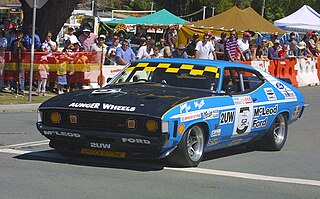
The 1974 Hardie-Ferodo 1000 was an endurance race for Group C Touring Cars, held at the Mount Panorama Circuit near Bathurst in New South Wales, Australia on 6 October 1974. The race was Round 3 of the 1974 Australian Manufacturers' Championship and was the 15th in a sequence of annual “Bathurst 1000” races commencing with the 1960 Armstrong 500.
The 1979 Hang Ten 400 was an endurance motor race held at the Sandown Park circuit in Victoria, Australia on 9 September 1979. It was staged over 129 laps of the 3.11 km circuit, a total of 401 km. The race was Round 1 of the 1979 Australian Championship of Makes and as such it was open to Group C Touring Cars. It was the fourteenth in a sequence of annual Sandown long distance races. The race was won by Peter Brock.
The 1973 Hardie-Ferodo 1000 was the 14th running of the Bathurst 1000 touring car race. This was the first race to be held under the new metricised distance of 1000 kilometres, rather than the 500 miles previously contested. It was held on 30 September 1973 at the Mount Panorama Circuit just outside Bathurst. The race was open to cars eligible to the locally developed CAMS Group C touring car regulations with four engine capacity based classes and it was the 3rd round of the 1973 Australian Manufacturers' Championship.
The 1975 Phillip Island 500K was an endurance race for Touring Cars complying with CAMS Group C regulations. The event was held at the Phillip Island circuit in Victoria, Australia on 23 November 1975. Race distance was 106 laps of the 4.73 km circuit for a race distance of 501 km.
The 1973 Phillip Island 500K was an endurance race for Group C Touring Cars, staged at the Phillip Island circuit in Victoria, Australia on 25 November 1973. Race distance was 106 laps of the 4.73 km circuit, a total distance of 501.38 km. The race, which was the fifth and final round of the 1973 Australian Manufacturers' Championship, was the third Phillip Island 500K.
The 1970 Sandown Three Hour 250 was an Australian endurance motor race for Series Production Cars. The event was held on 13 September 1970 over 130 laps of the 1.9 mile Sandown Park circuit in Victoria, Australia, a total of 247 miles. There were 42 starters in the event.
The South Pacific Touring Series was an Australian Touring car racing series held annually from 1970 to 1975 during the month of February in conjunction with the Tasman Series for open-wheelers. Races counting towards the series were staged at Surfers Paradise in Queensland, Warwick Farm and Oran Park in Sydney, Sandown Park in Melbourne and, from 1972, at the Adelaide International Raceway in South Australia.
The Sun-7 Chesterfield Series was an Australian touring car racing series staged at Amaroo Park in Sydney, New South Wales from 1971 to 1981. The actual series name varied from year to year, according to the commercial sponsorship secured by the series promoters, the Australian Racing Drivers Club.
The 1977 Australian Touring Car Championship was a CAMS sanctioned Australian motor racing championship open to Group C Touring Cars. It was the 18th running of the Australian Touring Car Championship. The championship began at Symmons Plains Raceway on 7 March and ended at the Phillip Island Grand Prix Circuit on 20 November after eleven rounds. 1977 was the second and final time that the series incorporated the longer distance races which made up the Australian Championship of Makes. These races included the Sandown 400 and the Phillip Island 500K, although notably not the Bathurst 1000.
The 1976 Australian Touring Car Championship was a CAMS sanctioned Australian motor racing title for Group C Touring Cars. It was the 17th running of the Australian Touring Car Championship. The championship began at Symmons Plains Raceway on 29 February and ended at the Phillip Island Grand Prix Circuit on 28 November in the longest season in the history of the series. 1976 saw a substantial change to the ATCC calendar which was expanded to eleven rounds, incorporating the end-of-season long distance Australian Championship of Makes races for the first time. These races included Sandown’s Hang Ten 400 and the Phillip Island 500K, although notably not the Bathurst 1000.
The 1981 Hang Ten 400 was an endurance race for Group C Touring Cars. The event, which was Round 3 of the 1981 Australian Endurance Championship, was staged on 13 September over 119 laps of the 3.1 km Sandown International Motor Racing Circuit circuit in Victoria, Australia. It was the 16th race in the history of what is now known as the Sandown 500.
The 1971 Sandown 250 was an endurance motor race open to Group E Series Production Touring Cars. The event was held at the Sandown circuit in Victoria, Australia on 12 September 1971 over 130 laps, approximately 250 miles. As a round of the 1971 Australian Manufacturers' Championship the race featured five classes based on Capacity Price Units with the CP Unit value for each model determined by multiplying the engine capacity of the vehicle in litres by its retail price in Australian dollars.
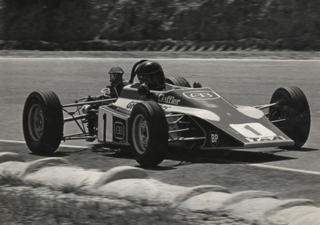
John Leffler is a former Australian racing driver. Leffler is best known for driving open-wheelers and winning the Australian Drivers' Championship in 1976.
